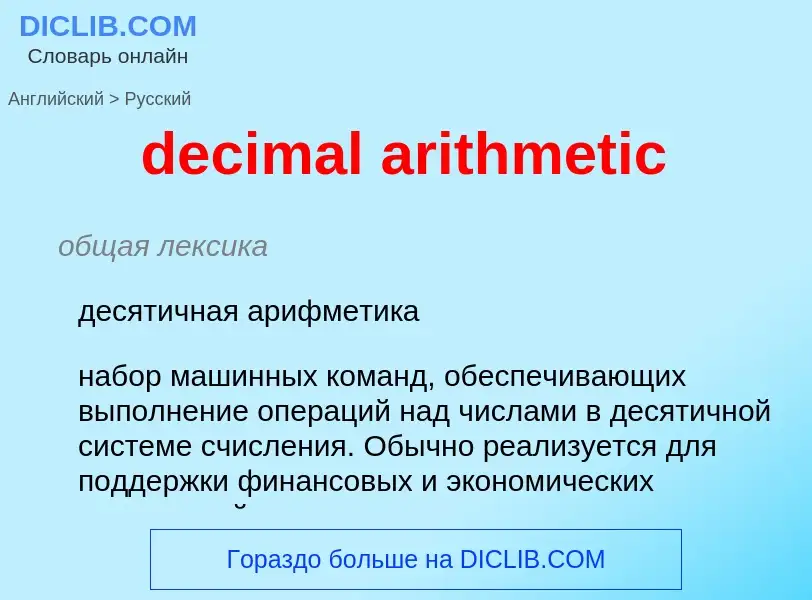Перевод и анализ слов искусственным интеллектом
На этой странице Вы можете получить подробный анализ слова или словосочетания, произведенный с помощью лучшей на сегодняшний день технологии искусственного интеллекта:
- как употребляется слово
- частота употребления
- используется оно чаще в устной или письменной речи
- варианты перевода слова
- примеры употребления (несколько фраз с переводом)
- этимология
decimal arithmetic - перевод на Английский
общая лексика
десятичная арифметика
набор машинных команд, обеспечивающих выполнение операций над числами в десятичной системе счисления. Обычно реализуется для поддержки финансовых и экономических приложений
Смотрите также
['desim(ə)l]
общая лексика
десятичное число
десятичный
записанный в десятичной системе счисления или использующий её
основание десятичной системы счисления
десятичная дробь
прилагательное
общая лексика
десятичный
децимальный
существительное
['desim(ə)l]
общая лексика
десятичная дробь
арифметические действия с десятичными дробями
десятичный знак
вычислительная техника
десятичное число
Определение
Википедия

The decimal numeral system (also called the base-ten positional numeral system and denary or decanary) is the standard system for denoting integer and non-integer numbers. It is the extension to non-integer numbers of the Hindu–Arabic numeral system. The way of denoting numbers in the decimal system is often referred to as decimal notation.
A decimal numeral (also often just decimal or, less correctly, decimal number), refers generally to the notation of a number in the decimal numeral system. Decimals may sometimes be identified by a decimal separator (usually "." or "," as in 25.9703 or 3,1415). Decimal may also refer specifically to the digits after the decimal separator, such as in "3.14 is the approximation of π to two decimals". Zero-digits after a decimal separator serve the purpose of signifying the precision of a value.
The numbers that may be represented in the decimal system are the decimal fractions. That is, fractions of the form a/10n, where a is an integer, and n is a non-negative integer.
The decimal system has been extended to infinite decimals for representing any real number, by using an infinite sequence of digits after the decimal separator (see decimal representation). In this context, the decimal numerals with a finite number of non-zero digits after the decimal separator are sometimes called terminating decimals. A repeating decimal is an infinite decimal that, after some place, repeats indefinitely the same sequence of digits (e.g., 5.123144144144144... = 5.123144). An infinite decimal represents a rational number, the quotient of two integers, if and only if it is a repeating decimal or has a finite number of non-zero digits.








![The world's earliest decimal multiplication table was made from bamboo slips, dating from 305 BCE, during the [[Warring States]] period in China. The world's earliest decimal multiplication table was made from bamboo slips, dating from 305 BCE, during the [[Warring States]] period in China.](https://commons.wikimedia.org/wiki/Special:FilePath/Qinghuajian, Suan Biao.jpg?width=200)


